
The Tephritidae are one of two fly families referred to as fruit flies, the other family being the Drosophilidae. The family Tephritidae does not include the biological model organisms of the genus Drosophila, which is often called the "common fruit fly". Nearly 5,000 described species of tephritid fruit fly are categorized in almost 500 genera of the Tephritidae. Description, recategorization, and genetic analyses are constantly changing the taxonomy of this family. To distinguish them from the Drosophilidae, the Tephritidae are sometimes called peacock flies, in reference to their elaborate and colorful markings. The name comes from the Greek τεφρος, tephros, meaning "ash grey". They are found in all the biogeographic realms.

Bactrocera tryoni, the Queensland fruit fly, is a species of fly in the family Tephritidae in the insect order Diptera. B. tryoni is native to subtropical coastal Queensland and northern New South Wales. They are active during the day, but mate at night. B. tryoni lay their eggs in fruit. The larvae then hatch and proceed to consume the fruit, causing the fruit to decay and drop prematurely. B. tryoni are responsible for an estimated $28.5 million a year in damage to Australian crops and are the most costly horticultural pest in Australia. Up to 100% of exposed fruit can be destroyed due to an infestation of this fly species. Previously, pesticides were used to eliminate B. tryoni from damaging crops. However, these chemicals are now banned. Thus, experts devoted to B. tryoni control have transitioned to studying this pests' behaviors to determine a new method of elimination.

The Tephritoidea are a superfamily of flies. It has over 7,800 species, the majority of them in family Tephritidae.
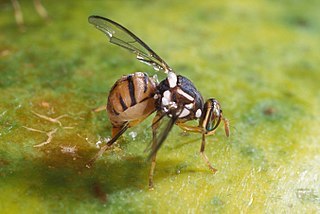
Bactrocera is a large genus of tephritid fruit flies, with close to 500 species currently described and accepted.
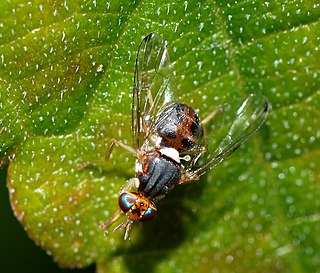
The Dacinae are a subfamily of the fruit fly family Tephritidae. Its 41 genera are distributed among three tribes:

Bactrocera dorsalis, previously known as Dacus dorsalis and commonly referred to as the oriental fruit fly, is a species of tephritid fruit fly that is endemic to Southeast Asia. It is one of the major pest species in the genus Bactrocera with a broad host range of cultivated and wild fruits. Male B. dorsalis respond strongly to methyl eugenol, which is used to monitor and estimate populations, as well as to annihilate males as a form of pest control. They are also important pollinators and visitors of wild orchids, Bulbophyllum cheiri and Bulbophyllum vinaceum in Southeast Asia, which lure the flies using methyl eugenol.

The Tephritid Workers Database is a web-based database for sharing information on tephritid fruit flies. Because these species are one of the most economically important group of insect species that threaten fruit and vegetable production and trade worldwide, a tremendous amount of information is made available each year: new technologies developed, new information on their biology and ecology; new control methods made available, new species identified, new outbreaks recorded and new operational control programmes launched. The TWD allows workers to keep up-to-date on the most recent developments and provides an easily accessible and always available resource.
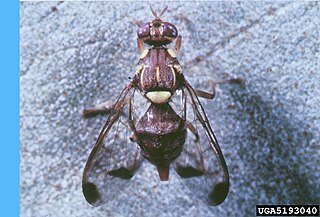
Bactrocera cucurbitae, the melon fly, is a fruit fly of the family Tephritidae. It is a serious agricultural pest, particularly in Hawaii.

Anoplomus is a genus of tephritid or fruit flies in the family Tephritidae found in Asia. Males court females with pheromone calling and special flight and ritualized movements. In some species small leks of males may display on vegetation. Many species feed on fruits, while some are known to feed on bamboos.
Paraspathulina is a genus of tephritid or fruit flies in the family Tephritidae.
Platensina is a genus of tephritid or fruit flies in the family Tephritidae.
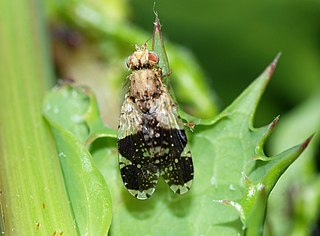
Tephritis is a genus of flies. It contains around 170 described species, making it the sixth largest genus in the family Tephritidae. Many more undescribed species are known from specimen collections. Tephritis occur throughout much of the world, but most are Palearctic. They can be found in a wide range of climate types, from hot semidesert to tundra. Most species inhabit the inflorescences of plants from several tribes in the family Asteraceae, and a few species cause galls to form.
Rhabdochaeta is a genus of tephritid or fruit flies in the family Tephritidae.
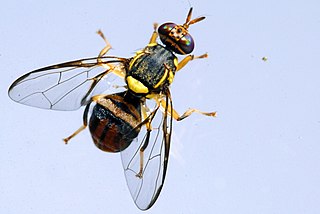
Bactrocera (Bactrocera) invadens is the name given to tephritid fruit flies that were introduced to East Africa from Sri Lanka and subsequently invaded practically the whole of Sub-Saharan Africa, hence the species name "invadens". It was first shown to be the same biological species as B. dorsalis s.s. by possessing identical sex pheromonal components after consumption of methyl eugenol, and also based on CO1 and rDNA sequences. Subsequently, it was agreed that B. invadens, B. papayae and B. philippinensis be synonymized as B. dorsalis. To counteract its detrimental effects to the fruit business, the industry resorts to cold treatment in order to get rid of the larvae.

Tephritini is a tribe of fruit flies in the family Tephritidae. There are about 80 genera and some 1000 described species in Tephritini.
An attractant is any chemical that attracts an organism, e.g. i) synthetic lures; ii) aggregation and sex pheromones ; and iii) synomone
Zeugodacus is a genus of tephritid or fruit flies in the family Tephritidae.

Bactrocera carambolae, also known as the carambola fruit fly, is a fruit fly species in the family Tephritidae, and is native to Asia. This species was described by Drew and Hancock in 1994.
Bactrocera passiflorae, the Fijian fruit fly, is a species of fly in the family Tephritidae in the insect order Diptera. It is native to several tropical and subtropical islands in the Pacific Ocean and is a pest of fruit crops.

Bulbophyllum sect. Sestochilos is a section of the genus Bulbophyllum.













